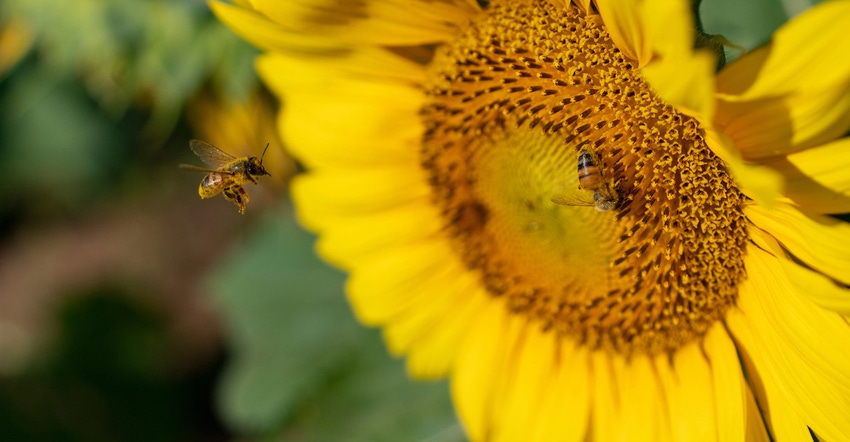
Pollinators serve a great purpose in the agriculture world. Without them, humans and animals would have little to no food at all.
Texas A&M AgriLife researcher Juliana Rangel, director of the Texas A&M Honey Bee Lab and associate professor of apiculture in the Texas A&M College of Agriculture and Life Sciences Department of Entomology, explains the impact such typically small animals and insects play in the role of our food supply.
Pollination’s unique role
To put it in perspective, Rangel explained how about 75% of plants rely on either animal or insect pollination. Pollination, the transfer of pollen from the male germplasm of a flower to the stigma of another flower, often creates a seed that will later turn into a crop like a fruit, vegetable or nut. The other 25% of pollination typically comes from natural elements like wind and water.
Pollination plays a dual role in the circle of life. It both provides pollinators with food during the process and humans with food as a result of the process.
During the pollination process, animals and insects collect pollen from a flower. The pollen itself acts as a source of protein as well as nutrients like amino acids, lipids, minerals, vitamins and essential elements, said Rangel. They receive their carbohydrates from floral nectar.
This hunt for food from the pollinators, in turn, pollinates the plants to make the food that we then consume. Without their hard work, things like almonds, some apples and citrus, cotton and many other agricultural crops would have little to none in the way of yield that would benefit the human population.
The weight of feeding the world may actually lie on the back of tiny insects – honeybees.
“Honeybees are arguably the most notable pollinator simply due to numbers and their ability to be easily managed,” said Rangel.
 (Laura McKenzie/Texas A&M AgriLife Marketing and Communications)
(Laura McKenzie/Texas A&M AgriLife Marketing and Communications)
Pollinator impacts in agriculture
Although there are thousands of native bees in the Americas, including bumblebees and carpenter bees, honeybees dominate the pollinator industry and pollinate most of the crops throughout the U.S.
Based off the last published study on the economic value of honeybee pollination, honeybees contribute an estimated $16 billion annually to the U.S. economy. This estimate is measured through their contributions to agricultural crops like almonds, apples, peaches, strawberries, citrus, cotton seed and other crops.
“Cotton alone experiences a 15%-25% increase in yield when honeybees are used for pollination,” she said.
Save the bees, other pollinators
There are several ways to help pollinators including planting pollinator-friendly gardens, mowing a little less often, using fewer pesticides and supporting research at the university level.
If you are interested in pollinator gardens, “consider purchasing seed mixes that are native to your area and come with a plethora of flowers that will bloom year-round,” Rangel said.
Although managed bees can receive supplemental food, wild bees rely solely on pollinator-friendly flowers. Often when purchasing plants, specific flowers and mixes will be labeled as pollinator-friendly and will be much preferred and beneficial to the pollinators themselves.
“You’ll want to provide big patches of similar flower options, so they can feed more pollinators,” Rangel said. “Offer plant diversity too. Different pollens have different types of amino acids and proteins for a diverse diet and proper nutrition.”
She also advised homeowners to consider not mowing as often and not using weed killers. The small flowers that pop up in the yard, which are often considered weeds to homeowners, are actually good bee forage.“If pesticides are unavoidable, be aware of your surroundings as much as possible,” she said. “Communicate with your neighbors and let them know you will be spraying, so they can protect their hives, if they have them, as much as possible.”
Protecting the future
Alternative ways to protect pollinators include supporting research at the university level that invests time and energy into research. Rangel’s own lab, the Texas A&M Honey Bee Lab has dedicated honeybee research within the Department of Entomology. It encompasses two facilities, a molecular lab on the main campus of Texas A&M University that focuses on genetic studies and the Janice and John G. Thomas Honey Bee facility on the RELLIS campus that includes even more research.
Depending on the year and the projects happening, the facility’s apiary may house anywhere from 40-80 honeybee colonies with the research focused on honeybee health and how to improve it.
Current studies are looking at the nutritional ecology of honeybees and whether or not honeybee foragers actively collect different types of pollen based on the colony’s nutritional needs. The focus is on how honeybees regulate their pollen intake and how they choose to feed based on whether or not they are infected by various pathogens. If this is the case, essentially bees would be partaking in self-assessed precision nutrition, selecting specific pollens depending on whether or not they are infected with pathogens.
If interested in beekeeping, Rangel suggests taking the time to truly educate yourself on the logistics and time that it will take to have successful hives. And for more on beekeeping, Texas A&M AgriLife Extension Service offers an online course for beginner beekeepers at tx.ag/Beekeeping101.
To learn how you can foster opportunities for honeybee research, you can contact Jansen Merrill with the Texas A&M Foundation or the Texas A&M Honey Bee Association.
Source: is AgriLife TODAY, which is solely responsible for the information provided and is wholly owned by the source. Informa Business Media and all its subsidiaries are not responsible for any of the content contained in this information asset.
About the Author(s)
You May Also Like




